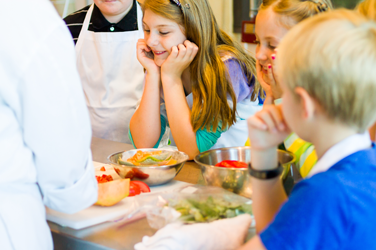Food brings people together. It nourishes and connects the community. And as a child in an immersion program, I discovered how food can play an important role even in language learning.
When I was little, learning French didn’t come easy. I often asked my parents to transfer me to the English program. Learning French in an English-speaking community was difficult, but my mom kept my heritage close by bringing me into the kitchen. Making French-Canadian recipes was where I practised the French language and listened to stories of my past. Interacting with my mom in the kitchen allowed me to continue to share these stories and recipes with my children and students today.
Real-world learning
The main challenge for second language development occurs when the students use the language within a limited scope, rather than using these skills to carry out real-world actions.Note 1 When children are learning a new language, hands-on activities and real-world experiences are much more impactful than theory alone.Note 2 Cooking with students is hands-on, integrated, and meaningful. The stories told during cooking provide students with increased vocabulary, connecting them to a rich history and giving them a purpose for learning these concepts.
Engagement in an immersive environment motivates students to learn another language, and cooking helps the children achieve that engagement. My best memories as a teacher were with my mom, listening to her French fingerplays and songs, dancing the gigue with her, and being her sous chef through the recipe demonstrations that kept my students hanging on every word she said. I found it fascinating how she kept the students engaged the entire time in French.
Intergenerational connections
Teaching children to cook isn’t new, but surprisingly, building intergenerational connections through cooking is a newer concept.Note 3 The intergenerational connections developed through storytelling and cooking experiences, especially in the early years, are an essential “soft skill” that has many significant ties to culture and second language learning.Note 3
Ways to get started
Unfortunately, cooking in elementary school is difficult. Elementary schools lack the resources needed, such as space, tools, and ingredients. I understand first-hand how difficult food storytelling experiences are to implement in a school setting. Through my Master of Education program, I have developed the Calgary Food Storytelling Initiative to bring these experiences closer to our students, providing increased opportunities in an elementary setting.
You too can make use of food storytelling. Taking that first step is the most important thing, whether the activity is classroom-based or school-wide. Below are a few ideas to get you started.
1. Ask students to share
Have students share their family stories, pictures, or heritage recipes with the class, which will increase verbal skills.
2. Invite grandparents
Ask grandparents within the community to come and share their stories or cook some recipes together. I use the staff kitchen for these activities. Alternatively, keep the cooking task within the classroom, and make a recipe that doesn’t need a stove. Or possibly assemble the recipe first, and then send a couple of volunteers to the kitchen to finish. Once the dish is complete, enjoy the meal together while sharing stories.
3. Use technology
Invite older generations to join your class on a video call if they have mobility challenges. Students can interview them, or they could walk the students through a recipe made in the classroom or kitchen in real time.
4. Maximize language learning
Read recipes together and ask questions to build comprehension. Make themed recipes such as spring chocolate pudding to increase vocabulary, or “print” out alphabet pancakes.
5. Use community resources
Connect students with retired adults who have specialized training in areas such as growing a garden or building garden boxes. Then make a recipe using ingredients from the garden. Within the Calgary Food Storytelling Initiative, we pair the skills of the older generation with the needs of our students. Likewise, students have acquired skills, such as computer skills or video use, that an older adult may be eager to learn.
Food storytelling: The way of the future
Learning another language isn’t easy. It takes a community to raise a child. Our older generations have many gifts to give and stories to tell. Learning from our past can generate interest, motivation, and passion for our students as they build connections with each other and learn a new language.
COVID-19 has isolated many. Learning from our past through traditional storytelling and recipes can bring us together again. Connection and themed integration will be critical educational components for our students in a post-COVID world.
What small step could you take today in your classroom or school that could foster positive intergenerational relationships through food and storytelling?

